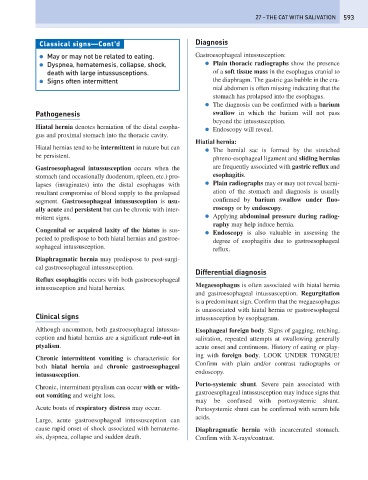Page 601 - Problem-Based Feline Medicine
P. 601
27 – THE CAT WITH SALIVATION 593
Classical signs—Cont’d Diagnosis
● May or may not be related to eating. Gastroesophageal intussusception:
● Dyspnea, hematemesis, collapse, shock, ● Plain thoracic radiographs show the presence
death with large intussusceptions. of a soft tissue mass in the esophagus cranial to
● Signs often intermittent the diaphragm. The gastric gas bubble in the cra-
nial abdomen is often missing indicating that the
stomach has prolapsed into the esophagus.
● The diagnosis can be confirmed with a barium
Pathogenesis swallow in which the barium will not pass
beyond the intussusception.
Hiatal hernia denotes herniation of the distal esopha- ● Endoscopy will reveal.
gus and proximal stomach into the thoracic cavity.
Hiatial hernia:
Hiatal hernias tend to be intermittent in nature but can ● The hernial sac is formed by the stretched
be persistent.
phreno-esophageal ligament and sliding hernias
Gastroesophageal intussusception occurs when the are frequently associated with gastric reflux and
stomach (and occasionally duodenum, spleen, etc.) pro- esophagitis.
lapses (invaginates) into the distal esophagus with ● Plain radiographs may or may not reveal herni-
resultant compromise of blood supply to the prolapsed ation of the stomach and diagnosis is usually
segment. Gastroesophageal intussusception is usu- confirmed by barium swallow under fluo-
ally acute and persistent but can be chronic with inter- roscopy or by endoscopy.
mittent signs. ● Applying abdominal pressure during radiog-
raphy may help induce hernia.
Congenital or acquired laxity of the hiatus is sus- ● Endoscopy is also valuable in assessing the
pected to predispose to both hiatal hernias and gastroe-
degree of esophagitis due to gastroesophageal
sophageal intussusception.
reflux.
Diaphragmatic hernia may predispose to post-surgi-
cal gastroesophageal intussusception.
Differential diagnosis
Reflux esophagitis occurs with both gastroesophageal
Megaesophagus is often associated with hiatal hernia
intussusception and hiatal hernias.
and gastroesophageal intussusception. Regurgitation
is a predominant sign. Confirm that the megaesophagus
is unassociated with hiatal hernia or gastroesophageal
Clinical signs intussusception by esophagram.
Although uncommon, both gastroesophageal intussus- Esophageal foreign body. Signs of gagging, retching,
ception and hiatal hernias are a significant rule-out in salivation, repeated attempts at swallowing generally
ptyalism. acute onset and continuous. History of eating or play-
ing with foreign body. LOOK UNDER TONGUE!
Chronic intermittent vomiting is characteristic for
Confirm with plain and/or contrast radiographs or
both hiatal hernia and chronic gastroesophageal
endoscopy.
intussusception.
Porto-systemic shunt. Severe pain associated with
Chronic, intermittent ptyalism can occur with or with-
gastroesophageal intussusception may induce signs that
out vomiting and weight loss.
may be confused with portosystemic shunt.
Acute bouts of respiratory distress may occur. Portosystemic shunt can be confirmed with serum bile
acids.
Large, acute gastroesophageal intussusception can
cause rapid onset of shock associated with hemateme- Diaphragmatic hernia with incarcerated stomach.
sis, dyspnea, collapse and sudden death. Confirm with X-rays/contrast.

